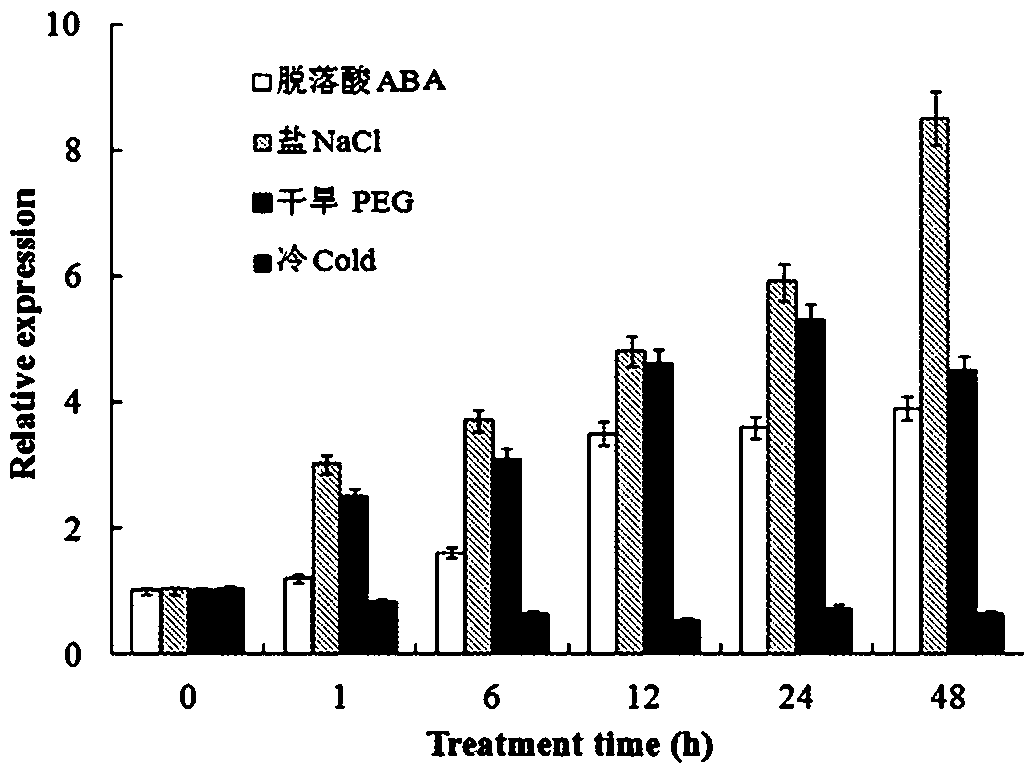HD-Zip I type transcription factor GmHDL 57 genes and application
A technology of transcription factors and genes, applied in application, genetic engineering, plant genetic improvement, etc., can solve the problems of lack of practical application value, stable transformation of japonicus japonicus seeds, etc., and achieve the effect of improving salt resistance
- Summary
- Abstract
- Description
- Claims
- Application Information
AI Technical Summary
Problems solved by technology
Method used
Image
Examples
Embodiment 1
[0034] A preparation method of the HD-Zip class I transcription factor gene GmHDL57 that improves the salt resistance of legumes, the steps of which are:
[0035] The seeds of cultivated soybean Williams82 were sterilized and placed in 1 / 2 Hoagland medium for germination and growth. The parameters of the light incubator were set at a temperature of 25 °C, a relative humidity of 60%, 18 hours of light and 6 hours of darkness. The root tissue of the seedlings was taken, and after quick freezing in liquid nitrogen, the total RNA of the root tissue of the seedlings was extracted according to the operation instructions of the RNA extraction kit of TaKaRa Company. The first-strand cDNA was prepared using the reverse transcription kit from TIANGEN. According to the GmHDL57 gene sequence published on the NCBI website (GenBank: XP_006574472.1), primers F-GmHDL57 (5'-ATGGCGAGTGGCAAGCTT TATGC-3') and R-GmHDL57 (5'-TCAATAGGGCCAGAAACAG-3') were designed to target the first strand of cDNA ...
Embodiment 2
[0037] The stress expression detection of GmHDL57 gene, its step is:
[0038] The seeds of cultivated soybean Williams82 were sterilized and placed in 1 / 2 Hoagland medium for germination and growth. The parameters of the light incubator were set at a temperature of 25 °C, a relative humidity of 60%, 18 hours of light and 6 hours of darkness. When the seedlings grow to the V1 stage (the first compound leaf stage), the abiotic stress treatment is carried out. The seedlings in the three experimental groups were treated with 1 / 2 Hoagland culture solution containing 100 μmol / L ABA, 100 mmol / L NaCl, and 30% PEG-6000, respectively. Another group of seedlings were transferred to a 4 °C incubator for cold treatment. There were 5 seedlings in each group, and 3 replicates were set up. The root tissues of the seedlings were collected at 0 h before the stress and 1, 6, 12, 24 and 48 h after the stress, and were quickly frozen in liquid nitrogen and stored in a -80 °C refrigerator for late...
Embodiment 3
[0042] A kind of HD-Zip class I transcription factor gene GmHDL57 that improves the salt resistance ability of legumes is applied in japonicus japonicus, and the specific implementation steps are as follows:
[0043] japonicus stable transformation:
[0044] (1) Construction of overexpression fusion vector
[0045] Insert the correctly sequenced target gene into the plant overexpression vector p1301U, the upstream primer is F-GmHDL57-OX (5'-CGggatccATGGCGAGTGGCAAG-3'), the downstream primer is R-GmHDL57-OX (5'-GGggtaccTCAATAGGGCCAGAAAC-3'), The lowercase letter area is the restriction site sequence BamH I and Kpn I, and the overexpression vector p1301U-GmHDL57 was constructed ( figure 1 shown in B). The extracted plasmid was electroporated to transform Agrobacterium tumefaciens EHA105.
[0046] (2) Preparation of Agrobacterium liquid
[0047] A single colony of Agrobacterium EHA105 was cultured in YEB liquid medium supplemented with 40 mg / L rifampicin and 50 mg / L kanamycin...
PUM
 Login to View More
Login to View More Abstract
Description
Claims
Application Information
 Login to View More
Login to View More - Generate Ideas
- Intellectual Property
- Life Sciences
- Materials
- Tech Scout
- Unparalleled Data Quality
- Higher Quality Content
- 60% Fewer Hallucinations
Browse by: Latest US Patents, China's latest patents, Technical Efficacy Thesaurus, Application Domain, Technology Topic, Popular Technical Reports.
© 2025 PatSnap. All rights reserved.Legal|Privacy policy|Modern Slavery Act Transparency Statement|Sitemap|About US| Contact US: help@patsnap.com



